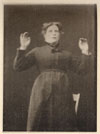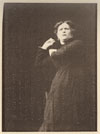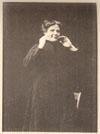



Suggestion by the muscular sense.
New York : G. P. Putnam's Sons, 1883.
Journal : The Journal of Mental and Nervous Disease.
Description : vol. x. (Jan.): pp. 1-13, [2 l. pl.] ; ill.: 3 fig., 4 photo. ; 23.5 cm.
Photographs : collotypes, 4 clinical portraits on 2 leaves.
Photographer : Albert Londe.
Subject : Hystero-Epilepsy — Catalepsy.
Notes :
Charcot postulated an organic cause to the conversion disorders which he treated at Salpêtrière, a theory which was attacked through the years, most recently with the historical revisions of Foucault, Didi-Huberman and numerous graduate school thesis writers who have gone so far as to accuse Charcot of manipulating his patients into performing in a sham circus. Most of this aspersive writing is derived from a shallow knowledge of neuropsychiatry, but as the instruments of brain imaging continue to advance, his critics will be silenced.
"We have obtained, with the aid of M. Londe, in charge of the photographic department at La Salpêtrière, a series of photographs, several of the most interesting of which we here reproduce, and concerning which we will remark that they were all taken during the first experiments attempted for this purpose on this patient.
"Figure I represents the patient in the cataleptic state. She was placed in this inexpressive attitude at the beginning of each one of the experiments that follow.
"I. If the two occipito-frontal muscles are excited by the faradic current, by placing an electrode at the level of each one of the two, the forehead at once wrinkles transversely, the eyelids are raised, the palpebral opening enlarges a little, the eye becomes fixed ; in a word, the physiognomy assumes the expression of astonishment, according to the rule established by the remarkable researches of Duchenne (of Boulogne). But this is not all – the expression thus imparted to the face by the contraction of a single muscle goes on to complete itself. The mouth opens lightly, though the depressor muscles of the lower jaw are not touched, and the arms are raised in semiflexion – the palm of the hand directed forward, as represented in fig. 2.




"Once produced, this attitude persists indefinitely, and the subject, continuously cataleptic, will not abandon the position, except for some other that may be imparted to her. For instance, if we lower the arms and place them vertically alongside the body, as in figure I, the physiognomy again becomes expressionless. Thus, in this experiment the reciprocal influence of attitude and of the physiognomy is successively exercised in opposite ways. In the first place, it is the physiognomy which induces the gesture intended to complete the expression which the physiognomy indicates, and then it is the gesture or attitude which, having been rendered inexpressive, reacts upon the physiognomy, which loses at the same moment its former expression.
"We know that the contraction of the orbicularis palpebrarum superior is characterized by a transverse corrugation of the eyebrows expressive of anger. As soon as we have caused this to contract in our cataleptic subject, the physiognomy assumes the expression indicated, and at the same time the fists clench, at the arms assume a fixed position of aggression and defence. (Vid. fig. 3.)
"The same holds true of the zygomaticus major, the muscle of laughing (vid. fig. 4); of the levator communis labii superioris alaeque nasi, the muscle of disdain ; and of the depressor anguli oris, the muscle of sadness.
"The same is true of those expressions which, in order to be complete (according to Duchenne), demand the simultaneous contraction of two facial muscles. For instance, the contraction of the occipito-frontalis and of the platysma myoides. This expression was easily obtained by the case of our patient and it was observed that the attitude was in harmony with the expression. The body is thrown backward, and the hands assume a position of warding off the approach of the object which causes her fright.
"But all the subjects upon which we have experimented have not presented an equal development of the phenomenon. We have been able to observe it very clearly upon four hysterical patients in our service, but in different degrees. — pp. 10-11.
